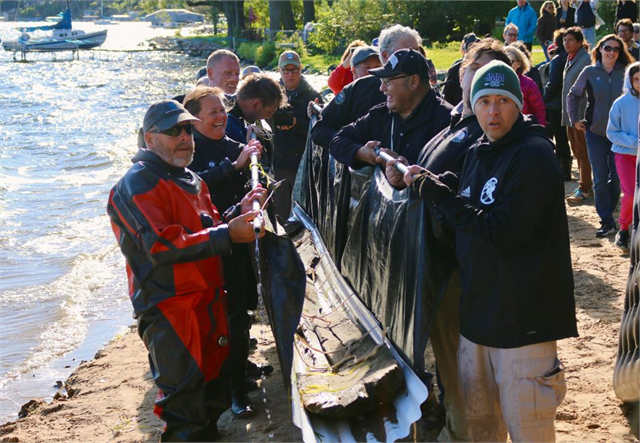
- Details
- By Darren Thompson
MADISON, Wisc.— On Thursday, Sept. 22, the Wisconsin Historical Society (WHS) recovered a 3,000-year-old dugout canoe from the bottom of a Madison lake with the assistance of two Wisconsin Tribes.
The canoe, recovered from Lake Mendota in downtown Madison, is about 14.5 feet long and carved from a single piece of white oak. According to the WHS, radiocarbon dating analysis performed on the recovered canoe places its origin at 1,000 BC — making it the oldest canoe ever discovered in the Great Lakes region by approximately 1,000 years.
It is the second canoe recovered in the last year from the same lake —last November, the WHS announced that it recovered a canoe that dated 1,200 years old. Both canoes were likely made by ancestors of the Ho-Chunk Nation.
“Finding an additional historically significant canoe in Lake Mendota is truly incredible and unlocks invaluable research and educational opportunities to explore the technological, cultural, and stylistic changes that occurred in dugout canoe design over 3,000 years,” WHS Archaeologist Dr. James Skibo said in a statement. “Since it was located within 100 yards of where the first canoe was found at the bottom of a drop-off in the lakebed, the find has prompted us to research fluctuating water levels and ancient shorelines to explore the possibility that the canoes were near what is now submerged village sites.”
Representatives from the Ho-Chunk Nation and Bad River Band of Lake Superior Chippewa joined the WHS to recover both canoes.
“These are things that we, as Ho-Chunk people, have known,” Ho-Chunk Nation Public Relations Officer Casey Brown told Native News Online. “A canoe finding isn’t revelatory to us because we have known we have been here for thousands of years.”
The canoe was first discovered in May 2022 by WHS Archaeologist Tamara Thomsen while diving in Lake Mendota, Madison’s largest lake.
Last year, Thomsen also discovered the first canoe recovered early this year.
The area of the lake the canoe was found in is populated, with homes and recreational boat traffic nearby.
“It was pure luck that someone from the [Wisconsin] Historical Society that is also a scuba diver happened to go there,” Brown said.
An end of the canoe was protruding out of the lake. Brown said that other divers likely had seen the canoe before but didn’t know what it was.
“To anyone else, this would look like a piece of wood, or driftwood, just sticking out of the water,” Brown said.
Brown went on to say that lower water levels — an effect of climate change — likely made the canoe visible.
Brown said that both canoes confirm that the Ho-Chunk people have been in the Madison area for thousands of years.
“Western academia, especially history, is based on evidence, or proof,” Brown told Native News Online. “Well, here’s a 3,000-year-old canoe. Anyone who wants to deny Indigenous history, it’s harder to do that now.”
Tell Us What You Think
More Stories Like This
Native News Weekly (August 25, 2024): D.C. BriefsUS Presidents in Their Own Words Concerning American Indians
Indigenous Actor Elaine Miles Reports Detention by Alleged ICE Agents
Happy Thanksgiving from Native News Online
Coming Up on Native Bidaské: Behind the Animation: Joey Clift Talks “Pow” and Native Storytelling
Help us tell the stories that could save Native languages and food traditions
At a critical moment for Indian Country, Native News Online is embarking on our most ambitious reporting project yet: "Cultivating Culture," a three-year investigation into two forces shaping Native community survival—food sovereignty and language revitalization.
The devastating impact of COVID-19 accelerated the loss of Native elders and with them, irreplaceable cultural knowledge. Yet across tribal communities, innovative leaders are fighting back, reclaiming traditional food systems and breathing new life into Native languages. These aren't just cultural preservation efforts—they're powerful pathways to community health, healing, and resilience.
Our dedicated reporting team will spend three years documenting these stories through on-the-ground reporting in 18 tribal communities, producing over 200 in-depth stories, 18 podcast episodes, and multimedia content that amplifies Indigenous voices. We'll show policymakers, funders, and allies how cultural restoration directly impacts physical and mental wellness while celebrating successful models of sovereignty and self-determination.
This isn't corporate media parachuting into Indian Country for a quick story. This is sustained, relationship-based journalism by Native reporters who understand these communities. It's "Warrior Journalism"—fearless reporting that serves the 5.5 million readers who depend on us for news that mainstream media often ignores.
We need your help right now. While we've secured partial funding, we're still $450,000 short of our three-year budget. Our immediate goal is $25,000 this month to keep this critical work moving forward—funding reporter salaries, travel to remote communities, photography, and the deep reporting these stories deserve.
Every dollar directly supports Indigenous journalists telling Indigenous stories. Whether it's $5 or $50, your contribution ensures these vital narratives of resilience, innovation, and hope don't disappear into silence.
 The stakes couldn't be higher. Native languages are being lost at an alarming rate. Food insecurity plagues many tribal communities. But solutions are emerging, and these stories need to be told.
The stakes couldn't be higher. Native languages are being lost at an alarming rate. Food insecurity plagues many tribal communities. But solutions are emerging, and these stories need to be told.
Support independent Native journalism. Fund the stories that matter.
Levi Rickert (Potawatomi), Editor & Publisher
